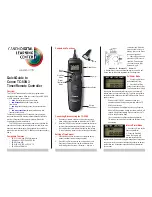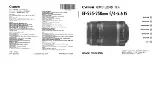
English
English
1. Sensor positioning/mounting:
The following installation locations are not advisable:
-
Heater vents (minimum distance 1 m)
-
Lead-acid battery (minimum distance 1.5 m)
-
Bathroom unit
1.1 Preparation for mounting:
Drill a hole at the mounting location (20 mm or 12 mm for
CO sensor)and press in the bushing provided from the outside.
1.2 Securing sensor:
Secure the sensor from the inside using the screws provided.
!!! Never use adhesives containing solvents or sealing
compounds containing silicone!!!
2. Mounting location of device:
- As there is no sensor in the device, the G.A.S.-pro can be mounted
at any desired location (including in a cabinet).
- Mounting in the immediate vicinity of the heater or boiler is not
advisable, as this can impair the dynamic temperature adjustment.
- If the G.A.S.-pro is mounted in a cabinet, the use of an external
siren (Art. No.:THG-2-00001) may be advisable, as the internal
buzzer might be overheard.
- As the power indicator is located on the front of the housing, the
use of an external power indicator (Art. No. THG-2-00004) may be
advisable when the device is mounted in a cabinet.
3. Connecting sensors/siren/automatic switch-off:
- The G.A.S.-pro can be operated with up to 3 sensors.
These can be either narcotic/bottled gas sensors, CO sensors
or a combination of the two.
- The G.A.S.-pro is equipped with an alarm output with which
any commercially available vehicle alarm system can be controlled.
- The external siren is used to scare off the perpetrator and to
alert possible passers-by.
- The G.A.S.-pro is equipped with the option of automatic
activation/deactivation via the vehicle ignition (active with
ignition switched off/inactive with ignition switched on).
For connection, see last page. This connection variant is
recommended. Should this variant not be possible, the G.A.S.-pro
can naturally also be operated with a switch (c12 V to the
„IGN“ terminal via a switch).
3. Connecting sensors/siren/automatic switch-off:
!!! All connection work must be carried out in the
deenergised state!!!
See last page for terminal diagram
4. Connecting to an alarm system:
- Most alarm systems operate with normally-closed (NC) contacts.
Connect the terminals marked “NC” and “COM” in series to one
of the inputs of your alarm system.
- If your alarm system operates with normally-open (NO) contacts,
connect the terminals marked “NO” and “COM” in parallel to one of
the contacts of your alarm system.
5. System operation and function:
- After
switch-on
, the G.A.S.-pro signals its readiness for operation
with three beep tones and the power indicator on the front of the
housing lights up continuously.
- Following the
warm-up phase
(approx. 4 min.), the power
indicator flashes periodically and the G.A.S.-pro is now able to
detect gas.
- In case of an
alarm
, the integrated siren and, if installed, the
external siren sounds for approx. 30 seconds. If, after an alarm
break of 30 seconds, gas is still present, the alarm sounds again.
With a carbon monoxide alarm, the external siren sounds for 10 sec.
- If a
sensor error
or a
cable defect
is determined during the
permanent self-diagnosis, a continuous tone sounds until the
defect is eliminated.
6. Operating test:
- Following installation, an operating test should be conducted with
each connected sensor.
6.1 Switch on the G.A.S.-pro and wait until the warm-up phase has
been completed, and the power indicator flashes.
6.2 Now allow cigarette lighter gas to flow onto Sensor 1. After a
few seconds the alarm sounds.
6.3 Wait approx. 30 seconds and repeat the process with all
connected sensors.
6.4 The operating test for the CO sensor is described in the manual
of the CO sensor.
6
7
Summary of Contents for 310/861
Page 14: ...Wiring diagramm 26 NC NO...































